

![]() The English Apple Man has had a mixed week; rising at 2.30am on Wednesday to take my son and family to Gatwick Airport 'en route' to their holiday in Malta; 'back home and in bed' by 5.15am; "what a difference travelling on our Motorways is at that time of day" but old age is catching up with me as I was 'shattered' for the rest of the day!
The English Apple Man has had a mixed week; rising at 2.30am on Wednesday to take my son and family to Gatwick Airport 'en route' to their holiday in Malta; 'back home and in bed' by 5.15am; "what a difference travelling on our Motorways is at that time of day" but old age is catching up with me as I was 'shattered' for the rest of the day!
On Thursday The English Apple Man joined HDC (Horticulture Development Company) members at an open day offering growers the chance to view an existing fruit wall system at Parsonage Farm, Cobham, Kent (by kind permission of Adrian Scripps Ltd).
Adrian Scripps Ltd has been a leader in 'fruit wall' growing systems; even before the term Fruit Walls became a generic term for narrow rows of taller tree systems.
The Horticultural Development Company (HDC) was established on 1 July 1986 with a remit to fund research and development and communicate results to growers. On 1 April 2003, the HDC was given responsibility for near-market R&D for the apple and pear industry.
Below extracts from The HDC website;
"This Open Day was an opportunity to view the early stages of the Fruit-Wall Management Trial. HDC has recently commissioned >FAST to set up two new trials on the fruit-wall system of production in apples. The first of these (TF 206) will begin later this year when new trees will be planted in a trial designed to compare different planting material for fruit-wall orchard systems for apple and the second; code named (TF 207) started this year to determine the optimum pruning time for fruit-wall orchard systems for Gala"
"The work will address questions about the correct time to prune in order to be able to draw up practical guidelines for orchard management. The long-term effects of mechanical pruning on tree vigour, yield and quality will be investigated over the course of the project so growers with these types of orchard can avoid any potential pitfalls, for example reductions in tree vigour".
What is The HDC?
Under the terms of the Agriculture and Horticulture Development Board Order, growers are required to pay a levy if they grow horticultural products (*specified in the Order below), sell products grown by them, or anything derived from such products grown by them, and have adjusted sales figures from these products or derivatives of £60,000 or more (in any year ending March 31).
Horticultural products covered by the AHDB Order include vegetables grown in the open (except potatoes where separate arrangements apply), fruit, flowers and bulbs, hardy and other nursery stock, protected crops and herbs. Mushrooms are also included, but pay on a different basis (see below). Full details are provided in the Order.
* Product areas are; Tree Fruit. Soft Fruit. Bulbs & Outdoor Flowers. Field Vegetables. Hardy Nursery Stock. Mushrooms. Protected Edibles. Protected Ornamentals.
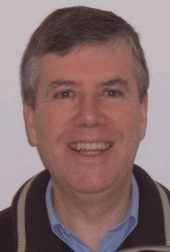 At Parsonage Farm around 60 visitors took the opportunity to follow the progress to date of the Fruit-Wall Management Trial. Leading the discussions - Tim Biddlecombe, MD of FAST.
At Parsonage Farm around 60 visitors took the opportunity to follow the progress to date of the Fruit-Wall Management Trial. Leading the discussions - Tim Biddlecombe, MD of FAST.
 Tim introduced Mark Holden - Production Director for Adrian Scripps Ltd and James Carew - who manages fruit trials at FAST. Also in attendance, Andrew Tinsley - HDC Research Manager (Fruit).
Tim introduced Mark Holden - Production Director for Adrian Scripps Ltd and James Carew - who manages fruit trials at FAST. Also in attendance, Andrew Tinsley - HDC Research Manager (Fruit).
Tim emphasised the increasing trend for Fruit Wall systems in apple growing, the move towards mechanical pruning in the UK and the wide use of Fruit Walls on the continent.
Fruit Walls seem to be THE future, but a lot of work needs to be done before a definitive 'Blueprint' can be agreed'
As mentioned, Adrian Scripps Ltd has been growing on a form of fruit walls for many years. The big change is the increasing potential for mechanical pruning. The choice of using Gala trees at Parsonage Farm is a logical one, with the variety now the 'number one' UK variety and a young Gala orchard 'conveniently' available for The HDC trials. The orchard used is now in its 3rd leaf. e.g. planted in the winter of 2009/10.
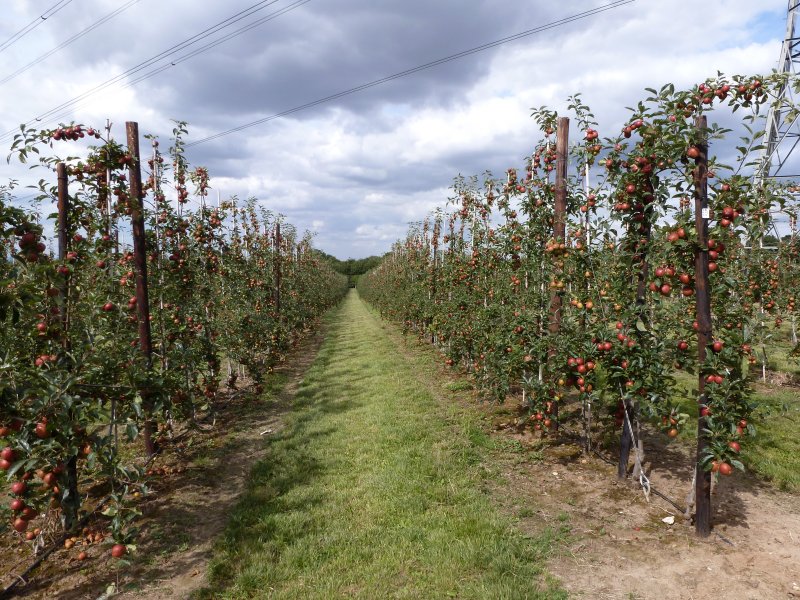
Tim Biddlecombe reviewed the aims of the trial; by trialing 5 pruning regimes administered at different stages and assessing; 1) Yield and grade out. 2) Tree growth. 3) Fruit maturity; (starch, sugar and fruit firmness at harvest). 4) Leaf and fruit mineral analysis, over a five year period, valuable data will be gained enabling a future 'blueprint' for UK growers.
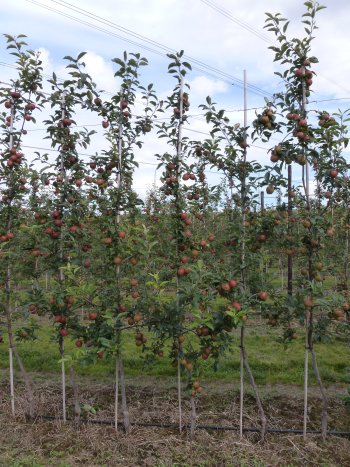 The 'optimum' timing of mechanical pruning is still an unknown quantity. Some information from France suggests just before blossom as the optimum, but other experiences suggest waiting for new growth to reach a stage where from 6 - 12 leaves have formed. Investigating the optimum stage is central to the HDC trial.
The 'optimum' timing of mechanical pruning is still an unknown quantity. Some information from France suggests just before blossom as the optimum, but other experiences suggest waiting for new growth to reach a stage where from 6 - 12 leaves have formed. Investigating the optimum stage is central to the HDC trial.
This summer (the 1st year of the trial) trial areas were pruned at; Pink Bud (30th April) 6th Leaf (29th May) 9th Leaf (14th June) and 10-12 leaves (7th July).
All options were also split into; with or without 'inter tree' hand pruning; each trial option is clearly identified.
The objective of the 'inter row' pruning is to compare the influence of allowing the wall to 'fill in' with branches along the row, and the results of more light penetration on the quality of fruit bud and the fruit itself.
Light is the key to all systems. To coin a phrase used by Tim Biddlecombe to me many years ago; " we are in the business of harvesting light" by this he meant light is key to fruit bud formation, plant health and fruit quality.
Light is necessary for the process of photosynthesis. Plants take the light they receive from the sun or other sources and convert it into sugar to provide fuel for growth and development. Plant leaves absorb red and blue light but reflect the green wavelength, which is why they appear green to the human eye.
We know the level of light in New Zealand is far in excess of the UK and in excess of most Top Fruit growing regions. Available light is a 'conundrum' constantly debated by technologist and grower who often have differing views of the ideal tree shape for apple growing in this country.
Many will argue that we should not plant trees too close together because of the lack of light. But observing trees at a wider spacing with the inevitable longer branches required for adequate crop, the fruit in the lower (shaded) areas struggles for good colour and sugars.
The height of the trees is also key; many will argue that anything over 7-8 feet (2-2.5 metres) will create detrimental shade on the lower areas of the tree, and certainly the width of the planting v the height of the trees is a key parameter.
The views of those at the cutting edge of tree system management is to keep the 'fruit wall' narrow, but use height to gain extra tonnage. This is commonplace in many countries and with careful management it is believed we can take advantage of extra height without losing yield and quality in the lower areas of the fruit wall.
The growing tendency to grow 'modern global varieties' like Gala, Braeburn, Jazz, Kanzi, Rubens and Zari should make this easier than it would have been with our older favourites like Cox.
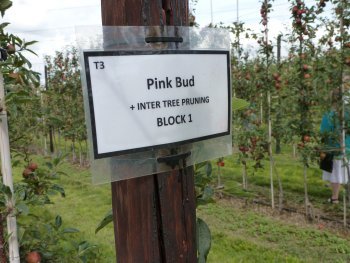
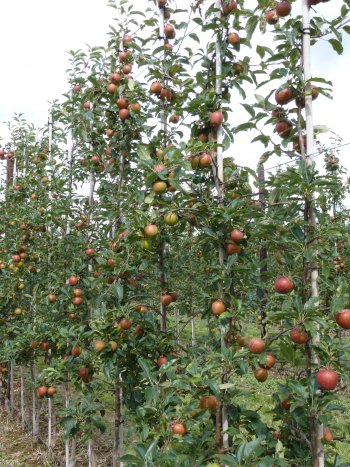
Measuring the effect of each option is a very detailed and time consuming task. Looking at the trees on Thursday one could see the cuts where fruit bud is forming and where it is not, but collating the results into a definitive answer will need an expert eye.
In the pictures below, cuts made by mechanical pruning are accompanied by; either fruit bud forming or vegetative growth; ideally fruit bud should develop behind the cut, either a single bud near the cut or more beneficially several fruit buds forming on the shoots behind the cut point.
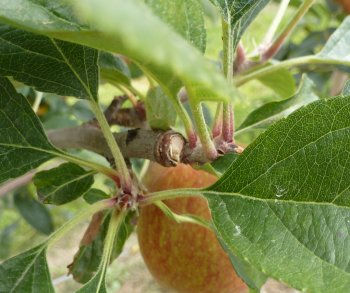
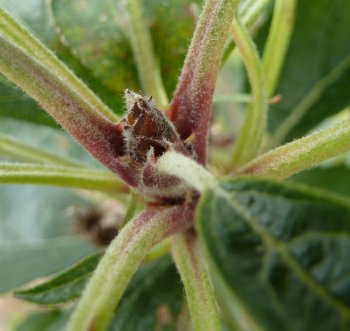
In the pictures below, we can see vegetative growth has 'taken off' indicating the cut was at the wrong stage.
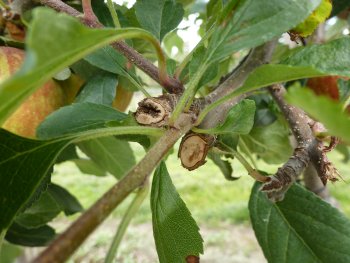
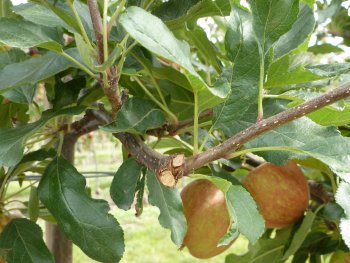
In discussion, Mark Holden told us the trial areas had all the fruitlets removed in the first summer (1st Leaf) to ensure adequate growth and produced yields of 20 tonnes per hectare in the 2nd Leaf. Mark is confident of 40 tonnes per hectare this year (3rd Leaf).
Tim Biddlecombe told us this was the first part of the HDC Fruit Wall trials and this winter the next stage (HDC TF206) a new orchard will be planted by FAST to test 5 tree types for suitability in the fruit wall system. This trial will include twin leader trees (Bibaum) which The English Apple Man believes will be an integral part of future orchard planning.
A visit to any Adrian Scripps Ltd farm is impressive; while there an opportunity to stroll through some of the orchards was not to be missed!
This season has been difficult for many growers, with certain varieties suffering more than others. Gala is once again the star attraction with close to normal yields predicted. It is poignant that any variety with Gala as a parent is also looking pretty good; Jazz & Kanzi the two that stand out.
Looking at Kanzi in comparison with Braeburn (no Gala parentage) at Parsonage Farm clearly emphasised this 2012 syndrome. Pictures below show Kanzi and Braeburn comparisons. Note the Braeburn has very little fruit on the lower branches, but a decent crop on the higher area of the central leader.
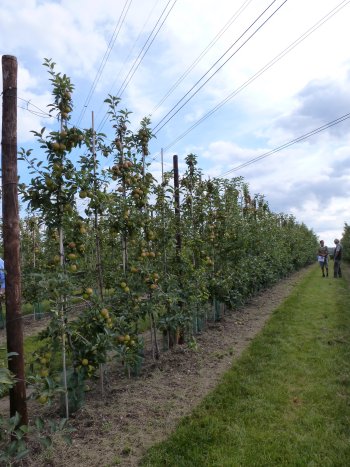
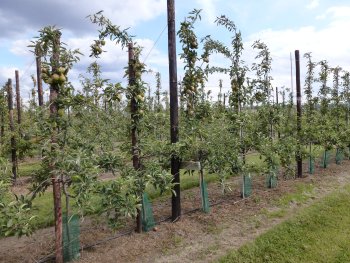
An explanation of this is the tendency for Braeburn to display biennial characteristics. The lower branches would have cropped heavily in 2011 (Braeburn yields last year were high) and 'stress on those areas' may have weakened the fruit bud and triggered the biennial nature. However the central leader did not 'over crop' and the bud strength was capable of setting a good crop.
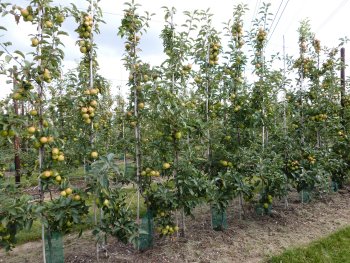
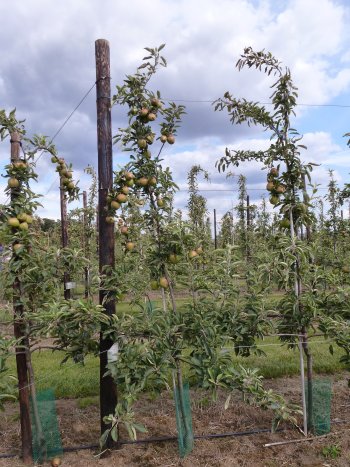
Finally, this Kanzi Orchard has been enhanced by the use of Extenday Reflective Cloth, a reflective sheet which is placed on the grass between the rows to improve light penetration into the lower regions of the tree. EXTENDAY enhances the quality of the fruit bud for the next year and aids maturity, colour and eating quality to this years fruit.
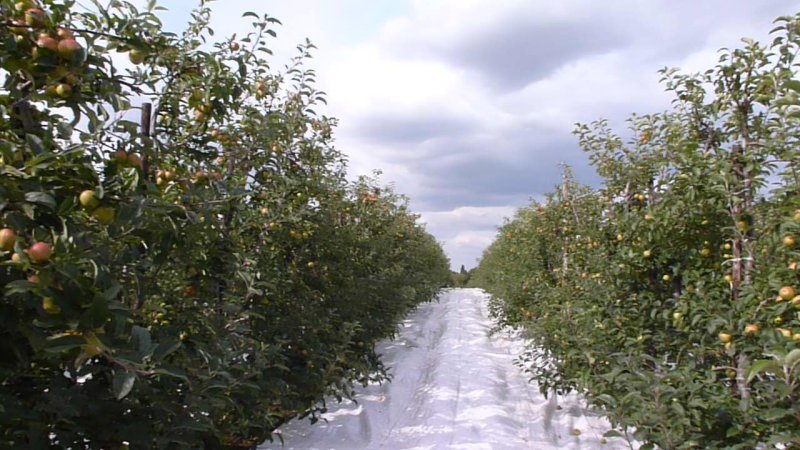
Mark Holden told me this orchard produced a yield of 72 tonnes per hectare in 2011. He does not expect it to be as high this year due to the challenges of the 2012 season, but probably still circa 60 tonnes!
Next week I hope to be in East Kent looking at a new venture. Watch this space!
Take care
The English Apple Man